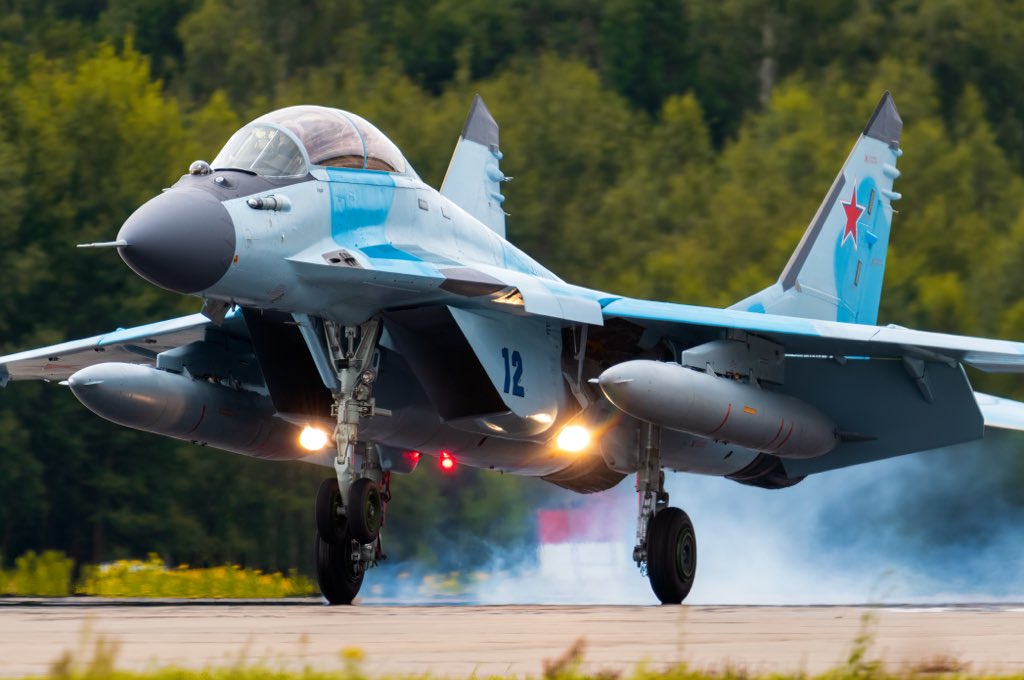Indian Air Force is in the process to acquire more Su-30MKIs and MiG-29 fighter jets from Russia. Earlier, Moscow responded to India’s MMRCA tender and pitched its MiG-35 fighter jets after receiving great appreciation for Mig-29 jets by the Indian military.
“The Russian side placed this jet [MiG-35] in the tender for the delivery of 110 medium fighter jets for the Indian Air Force,” Dmitry Shugaev, the Russian Federal Service for Military-Technical Cooperation told Sputnik.

After the acquisition of 36 Rafale jets, the Indian Air Force is looking to further bolster its fighter jet fleet.
In the MMRCA contract, the MiG-35s will be pitched against French Rafale jets, Eurofighter Typhoons, SAAB Gripen, US jets that include F-16, F-21 and F-18 Super Hornets besides Russian Sukhoi Su-35 fighters.
More MiGs and Sukhois
While New Delhi looks for more fighters, India will also acquire 21 Russia’s MiG-29 fighters and 12 Su-30 MKI aircraft from Russia.
Last year amid the India-China border clash, India’s Defense Acquisition Council approved the proposal to acquire more Russian jets and also upgrade 59 MiG-29 jets that India already operates.
As EurAsian Times reported, Russia recently handed a commercial offer to India to deliver 21 MiG-29 fighter jets, Valeria Reshetnikova, a spokeswoman for Russia’s Federal Service for Military-Technical Cooperation, confirmed.

Many experts had also challenged India’s logic to go with MiG-29s instead of the latest Rafale fighter jets. Aviation expert Tom Cooper had questioned why the Indian air force wanted more Su-30s and MiG-29s instead of Rafales jets.
According to Cooper, the Su-30, while powerful on paper, lacks performance and combat capability compared with Rafale jets or eve MiG-29 fighters.
He also points out that the Sukhoi Su-30 jets had failed to make a mark during the Kargil war in 1999 and Balakot Airstrikes in 2019 and instead India relied on the old Dassault Mirage-2000s.
India Happy With MiG-29 Upgrades
In 2019, India has asked Russia to modernize Su-30MKI fighter jets used by the Indian military, Birender Singh Dhanoa, the then chief of the Air Staff of the Indian Air Force, said in an interview.
New Delhi was happy about the program of modernization of the Russian MiG-21, MiG-27 and MiG-29 jets, used by the Indian Air Forces, Dhanoa said in the interview with the Russian Armed Forces’ official newspaper, Krasnaya Zvezda.
These aircraft had received modern weapons and avionics systems due to the program, which had been successfully tested, Dhanoa had pointed out.
Meanwhile, the Su-30 jets have been used by India for almost 20 years so New Delhi had asked Moscow to modernize the aircraft in line with existing needs, too, the military official explained.
MiG-29 Jets – What Makes Them Unique
Earlier last year as EurAsian Times reported, the Indian Navy deployed around 20 MiG-29 jets near the China border to reinforce its air force and counter Chinese PLAAF jets.
The MiG-29Ks were supposed to fly from the Vikrant aircraft carrier. Since the carrier was behind schedule, India decided to send its MiGs to support the airforce against possible Chinese incursions.
Despite issues with engine reliability, the MiG-29 with its 27-ton maximum weight seemingly works better in high altitudes than heavier fighter jets like Su-30MKIs. The MiG-29’s superior performance in challenging environments, compared to the bulkier Sukhoi jets is old news now.
Experts note that the Su-33 and its Chinese version – the J-15 is painfully sluggish like the Su-30s. It’s not for no reason that the Russian Navy is replacing its Su-33 jets with reliable MiG-29Ks that the Indian Navy also operates.
MiG-29: Powerful & Reliable
The first MiG-29 was commissioned into the Soviet Air Force almost 40 years ago to counter the US F-15 Eagle and F-16 Falcon.
It was a magnificent and successful design and has been operated by more than 25 nations, including the US (which was used for evaluation and testing purposes). India was the first export customer of these splendid jets.
While the airframe design is almost half a decade old, the warplane continues to be a tough competitor against US jets. The MiG-29 jets are highly appreciated for their agility, maneuverability, and most importantly reliability.
The fighter jet represents an extensive modernization of the most advanced aircraft of the Cold War era, the MiG-29A, and unlike other modernized variants such as the MiG-29SMT recently delivered to Syria or the MiG-29UPG on order from India (stated as the most advanced MiG-29 variant), they use new airframes with advanced composite materials and a distinctively different appearance.
The MiG-29M also has a highly capable twin-seat variant, the MiG-29M2, which is expected to be received as part of the order. Unlike the older twin-seat variants of the MiG-29s, the MiG-29M2 does not make compromises to the sensor suite to accommodate an extra crew member and is designed for high-end combat rather than exclusively for training.
The MiG-29M was developed from the carrier-based MiG-29K variant of the aircraft family. Having a tougher and revised design, the new airframes were constructed from a lightweight Aluminium-lithium alloy to increase the thrust-to-weight ratio.
The air intake ramps’ geometry was revised, the upper intake louvers were removed to make way for more fuel in the LERXs, mesh screens were introduced to prevent foreign object damage (FOD), and inlet dimensions were enlarged for higher airflow.
Main sensor upgrades consist of the Zhuk-ME pulse-Doppler airborne radar, along with revised IRST systems, a helmet-mounted target designation system, and electronic countermeasures. The new radar is capable of detecting air targets at ranges up to 120 km, track-while-scan of ten targets while engaging four targets at a time.
The jet is also equipped with the new RD-33MK engine, which has seven percent more thrust than its antecedents. For air-to-air combat, its weapons package includes the R-77 and R-27 beyond visual range missiles, R-73 short-range missiles, and is fitted with a 30mm Gsh-30-1 cannon.
For air-to-surface operations, it can operate the Kh-29, Kh-31, Kh-35 missiles, and various precision-guided bombs.




